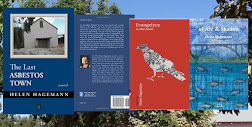 My Arvon Experiences - Clun Shropshire
My Arvon Experiences - Clun Shropshire
I like writing residencies. There is something unique about time spent away (esp. overseas) and being among other artists. These are people of like minds and it's always a pleasure to talk about your work and discuss common threads. Most writers will tell you that time spent at a writer's retreat is often very productive. In 2011, I spent three weeks at the Tyrone Guthrie Centre in Ireland. In 2014, I had the luxury of one month at Can Serrat, El Bruc Barcelona. This year, 2015, I could only manage a week at The Hurst, Arvon Foundation, Shropshire England.

Yet in all these residencies I have managed to work solidly on a writing project and get things done. I must admit, however, Barcelona, was too good a place not to see all the highlights. Also I visited Madrid, so not a lot of writing done in that retreat. Best of all however, was meeting two wonderful American art teachers, Paige and Geoff Byrne. They managed to take me under their wings and we had the best fun. After all, we were free to roam the country and who couldn't resist visiting the city of Barcelona, its many wonderful attractions especially Gaudi's architecture.

These pictures are from my June 2015 retreat in Shropshire. Unfortunately, only 5 days were spent at Arvon. I would have loved three weeks! Nevertheless, I managed to revisit my novel
The Ozone Cafe, edit the work to all past tense, include another chapter on the actual build of the cafe, and on the last night read a small scene which details a mural that Vincenzo creates on the wall of the cafe. Some of the comments were very inspiring, two writers who I had spoken to previously felt that it was a very emotional part of the novel. Such great feedback was invaluable. It made me love my novel even more, and has made me more determined to get the manuscript (firstly) to an editor, and hopefully then to a publisher.
The two top pictures are of Clun, a tiny township not far from The Hurst. A warm and cozy cafe offered the internet which was a bonus, especially as we were out in the wilds of the Shropshire Hills. Also that the Centre's policy dictated no mobile phones, no internet, no television. Of course, except for meals, there was nothing else to do but "write"!
Views of the many walks on the property at Arvon. You have the choice of a quiet, but very dark and tall forest walk. Or the main entrance into the property, that has open fields, a small river running nearby, and a quick hop, skip and jump along the main road. Be warned, however, the road is narrow with very high hedges and no footpath.
A glimpse of the beautiful rhododendrons in the rear garden. Some of the writers picked bunches of them and decorated the evening table. The pinks and mauves added colour to a table setting of wine, good food and good company.
I was fortunate enough to occupy a room that faced south. So every morning, the sun streamed into the room bringing warmth and cheer. I was on the second floor and had a beautiful view of the front of "The Hurst" and down further into the valley and beyond. It was wonderful to sit each morning and look out, especially since the weather was sunny, although a little chilly in the early morning.
Most writers took the opportunity to walk the property, some not really enjoying the dark, dark forest, as I soon discovered. It was eerie and totally isolated. I chose the warmer, lighter and more level paths down to the main road. I did walk along the main road for about 10 minutes, then turned around, making sure my total walk was 25-30 minutes each day.







































